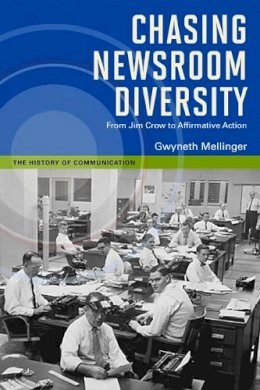
Stock image for illustration purposes only - book cover, edition or condition may vary.
Chasing Newsroom Diversity: From Jim Crow to Affirmative Action
Gwyneth Mellinger
€ 35.34
FREE Delivery in Ireland
Description for Chasing Newsroom Diversity: From Jim Crow to Affirmative Action
Paperback. Details missed opportunity in the newspaper industry's diversity efforts Series: History of Communication. Num Pages: 264 pages, 20 black and white photographs. BIC Classification: 1KBB; 3JJ; GTB; GTC; JFD; KNTJ. Category: (P) Professional & Vocational. Dimension: 230 x 175 x 25. Weight in Grams: 436.
Social change triggered by the Civil Rights Movement in the 1960s sent the American Society of Newspaper Editors (ASNE) on a fifty-year mission to dismantle an exclusionary professional standard that envisioned the ideal journalist as white, straight, and male. In this book, Gwyneth Mellinger explores the complex history of the decades-long ASNE diversity initiative, which culminated in the failed Goal 2000 effort to match newsroom demographics with those of the U.S. population. Drawing upon exhaustive reviews of ASNE archival materials, Mellinger examines the democratic paradox through the lens of the ASNE, an elite organization that arguably did more than any other during the twentieth century to institutionalize professional standards in journalism and expand the concepts of government accountability and the free press. The ASNE would emerge in the 1970s as the leader in the newsroom integration movement, but its effort would be frustrated by structures of exclusion the organization had embedded into its own professional standards. Explaining why a project so promising failed so profoundly, Chasing Newsroom Diversity expands our understanding of the intransigence of institutional racism, gender discrimination, and homophobia within democracy.
Product Details
Format
Paperback
Publication date
2013
Publisher
University of Illinois Press United States
Number of pages
264
Condition
New
Series
History of Communication
Number of Pages
264
Place of Publication
Baltimore, United States
ISBN
9780252078941
SKU
V9780252078941
Shipping Time
Usually ships in 7 to 11 working days
Ref
99-1
About Gwyneth Mellinger
Gwyneth Mellinger is a professor and chair of the Department of Mass Media and Visual Arts at Baker University. A volume in the series The History of Communication, edited by Robert W. McChesney and John C. Nerone
Reviews for Chasing Newsroom Diversity: From Jim Crow to Affirmative Action
Frank Luther Mott / Kappa Tau Alpha Research Award, 2013. "Gwyneth Mellinger's Chasing Newsroom Diversity: From Jim Crow to Affirmative Action offers explanations for 'why an effort so promising failed so profoundly.' In explaining the failure, the book provides a meticulous documented view of the ASNE over a fifty-year span, beginning in the mid-1950s. The work provides an excellent foundation for further studies on newsroom diversity."
American Journalism "Using the insights of whiteness studies and a rich array of primary sources, Mellinger demonstrates how and why the American Society of Newspaper Editors failed to achieve its 1978 diversity initiative's hiring goals by the goal year of 2000. She persuasively argues that whiteness (and maleness) consistently operated as a professional norm within the ASNE across time, even as the organization's leaders attempted to diversify newsrooms across America. A compelling and provocative book."
Kathy Roberts Forde, author of Literary Journalism on Trial: Masson v. New Yorker and the First Amendment “Provides a compelling explanation for how forward-thinking goals can be felled by institutional prejudice. . . . Anyone interested in the social movements of the twentieth century will find the book a worthwhile read.”—Journalism History "Chasing Newsroom Diversity provides a thoroughly reported account of the evolution of ASNE's approach to minority recruitment and the feeble implementation of that goal in the workplace."
Newspaper Research Journal "The work provides an excellent foundation for further studies on newsroom diversity. As a teaching tool, the book also would likely prompt lively classroom discussions."
American Journalism "Mellinger provides a very useful and most informative case study of how one professional organization addresses some deeply embedded, institutionalized norms with social, political and cultural implications over an extended period of time
50 years, with insight into the degree of difficulty it had in trying to dismantle them."
Gateway Journalism Review
American Journalism "Using the insights of whiteness studies and a rich array of primary sources, Mellinger demonstrates how and why the American Society of Newspaper Editors failed to achieve its 1978 diversity initiative's hiring goals by the goal year of 2000. She persuasively argues that whiteness (and maleness) consistently operated as a professional norm within the ASNE across time, even as the organization's leaders attempted to diversify newsrooms across America. A compelling and provocative book."
Kathy Roberts Forde, author of Literary Journalism on Trial: Masson v. New Yorker and the First Amendment “Provides a compelling explanation for how forward-thinking goals can be felled by institutional prejudice. . . . Anyone interested in the social movements of the twentieth century will find the book a worthwhile read.”—Journalism History "Chasing Newsroom Diversity provides a thoroughly reported account of the evolution of ASNE's approach to minority recruitment and the feeble implementation of that goal in the workplace."
Newspaper Research Journal "The work provides an excellent foundation for further studies on newsroom diversity. As a teaching tool, the book also would likely prompt lively classroom discussions."
American Journalism "Mellinger provides a very useful and most informative case study of how one professional organization addresses some deeply embedded, institutionalized norms with social, political and cultural implications over an extended period of time
50 years, with insight into the degree of difficulty it had in trying to dismantle them."
Gateway Journalism Review
